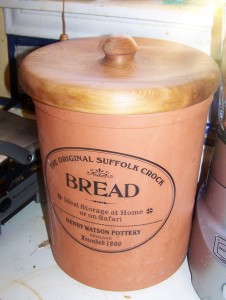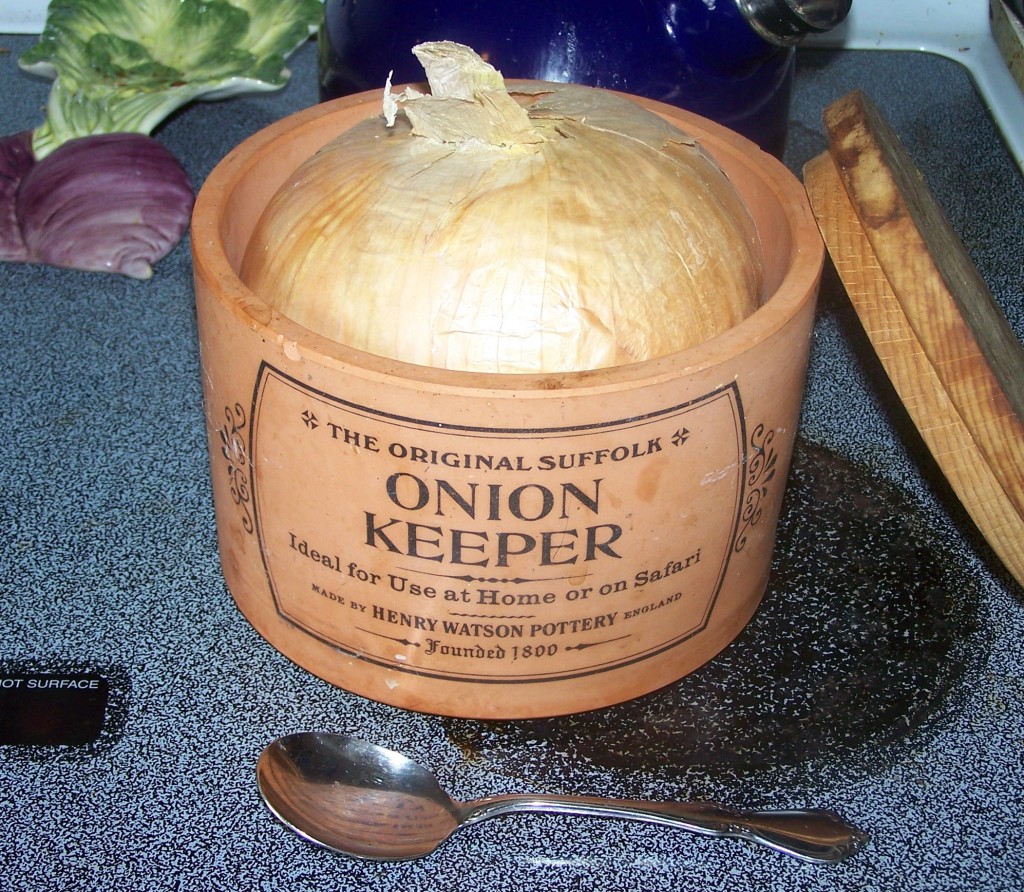Some years ago, Blondie or I bought a Henry Watson Pottery bread crock at a local Tuesday Morning outlet; it’s a sturdy lidded terra cotta pottery container for bread, as it says on the side of it. I had bought a number of other Henry Watson Pottery items over the years, as they turned up here and there in the BX; there was a garlic jar, and one for onions with a wooden top, a container for sugar with a gasket-sealed top … just nice, attractive and sturdy storage containers. There was also a lasagna pan, much lamented when it broke, as it was glazed on the inside and was the perfect size for the stuff that I baked. Not just lasagna let it be known. With a small baking rack inside, it was perfect for baking a whole small chicken.
The pottery lid of the bread crock broke. It broke several times, the last time in so many pieces that it was not possible to piece it together, and so for some years it went lidless … not a satisfactory situation, really. Being newly annoyed by this in mid-January and having a little money ahead, I looked around on line for a replacement lid; alas, coming up empty. The crock is still manufactured, it appears, and once uponnatime, the Watson Pottery did have a replacement lid available, but no longer. There wasn’t even such to be found on E-bay. Well, never mind, thought I … I can find some wood discs of a size to fit at a hobby shop, glue them together, slap a wooden drawer pull on top, sand the whole assembly smooth, slap some stain and varnish on it and – hey, a functional lid!
 Nope. The inside diameter of the crock was about 7.25 inches, the outside 9.50, and nothing available in the various hobby shops, online or otherwise, came even close. Either to large or too small, and not having a woodworking lathe other than the tiny Dremel lathe that I bought ages ago to do miniature woodworking on … sigh. Wit’s end, until I remembered one of our neighbors. He does lovely custom woodwork in his garage, open to the street, as a hobby, lavishing the results on family. He lives in a rental, two houses up from us … and, yeah. I took the measurements to him; he fished out a three inch thick scrap round from his woodpile and after a couple of days, turned us a lovely lid, to exact specifications. Fits like a dream, looks better than the original lid!
Nope. The inside diameter of the crock was about 7.25 inches, the outside 9.50, and nothing available in the various hobby shops, online or otherwise, came even close. Either to large or too small, and not having a woodworking lathe other than the tiny Dremel lathe that I bought ages ago to do miniature woodworking on … sigh. Wit’s end, until I remembered one of our neighbors. He does lovely custom woodwork in his garage, open to the street, as a hobby, lavishing the results on family. He lives in a rental, two houses up from us … and, yeah. I took the measurements to him; he fished out a three inch thick scrap round from his woodpile and after a couple of days, turned us a lovely lid, to exact specifications. Fits like a dream, looks better than the original lid!
For this exercise of skill and artistry, we traded a half-pint jar of home-made calamondin orange marmalade (made from the fruit of this odd ornamental that I bought years ago – it’s a native of the Philippines, and this was the first year that it actually bloomed and bore fruit) and a week’s worth of a dozen completely organic and totally free-range eggs, fresh from the chicken’s butts. Because … neighbors.
I thought on this, in hearing from another neighbor, who had a yard sale this weekend, because she and her husband are selling their house on a particularly quiet side street and moving. Their house sold in double quick time; according to their realtor, the particular zip code is a very “hot” one, and our neighborhood is particularly desirable. Not a surprise to us, really; it’s a quiet, and affordable neighborhood, close to schools, markets, gainful employment and military bases. Again, the affordable part; someone working a moderately well-paid job in this part of San Antonio would be able to purchase a house here without going broke on it or having to live on Top Ramen for thirty years. I managed the mortgage easily on an E-6 salary, and subsequently on the pension for same, although sometimes there were some dicey months. Some residents have amazing small gardens, kids play in front and back yards, people walk their dogs or run at all hours, decorate for holidays, know each other by sight well enough to wave. Nothing that will ever be on the Parade of Homes, in Architectural Digest or Country Living, or even, God help us, run the risk of becoming a historical district, unless in a hundred years, late 20th century residential developer becomes a significant aesthetic marker. (Although, seeing as the great and the good seem to prefer us all living in bare concrete stack-a-prole high-rises, perhaps a neighborhood like ours might very well become a suburban treasure. After all, Levittown has, in some appreciative circles.)
The eggs, by the way, are very popular and much appreciated by those neighbors that have received a selection of Carly and Maureen’s finest fresh-laid. After all, the girls lay them at the rate of one a day, most days, and we can’t possibly eat them at the rate of one each per day. We also hope that giving away the surplus will make those close neighbors feel more kindly towards Larry-Bird when he crows in the wee hours of the morning. As it happens, the closest neighbors rather like the sound of Larry and the girls, all having grown up in the country with chickens. It makes the neighborhood feel more home-like, I guess.
And everyone appreciated the Christmas fudge, as well. We distributed this years’ batch almost two months ago, and people are still telling us how very, very good it was. The goodwill is also repaid in kind – this weekend we have about two pounds of fresh homegrown Brussels sprouts from one of the keenest gardeners around – she has an allotment in a community garden, where she volunteers, which is fortunate for her yard isn’t any bigger than ours. And that’s how it goes, in a suburban neighborhood, where most everyone is willing to do the necessary, neighborly thing.




Recent Comments